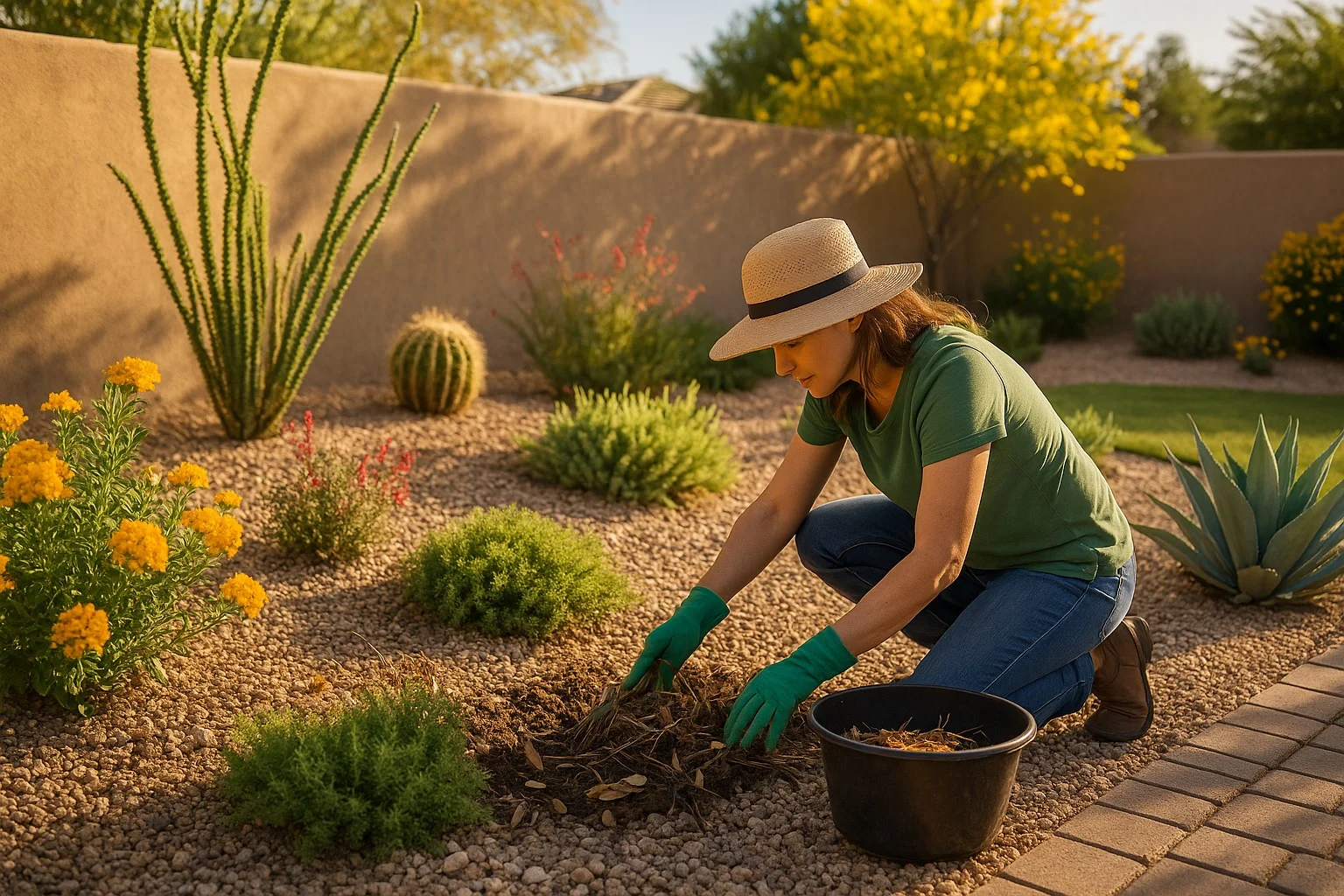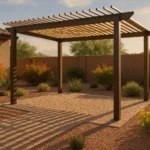As the mild Gilbert winter gives way to spring, it’s time to roll up our sleeves and get our gardens ready for the vibrant growing season ahead. Here in the Southeast Valley, spring cleanup isn’t just about aesthetics—it’s an essential practice that sets the foundation for a thriving garden throughout our intense summer months. I’ve spent years perfecting my spring garden routine in Gilbert, and I’m excited to share what works specifically for our unique desert climate and soil conditions.
Spring garden cleanup in Gilbert looks a bit different than what you might see in gardening magazines from cooler regions. Our cleanup needs to account for our early growing season, water conservation needs, and preparation for the scorching summer ahead. With proper planning and the right approach, your spring cleanup can make the difference between a garden that merely survives and one that truly flourishes in our Arizona environment.
Why Spring Cleanup Matters in Gilbert Gardens
In Gilbert’s desert climate, spring garden cleanup carries special significance. Unlike northern regions where gardens lie dormant under snow, our mild winters mean plants continue growing—albeit slowly—throughout the cooler months. By February and March, when our spring truly begins, garden beds often contain a mix of winter weeds, debris from winter storms, and plants that may have suffered frost damage during our occasional cold snaps.
Spring cleaning your garden isn’t just about appearances; it’s about plant health and pest management. Dead plant material provides hiding places for harmful insects that become active as temperatures rise. In Gilbert, where we can see temperatures climbing into the 80s by March, pests emerge earlier than in many parts of the country. Removing debris eliminates these hiding spots and helps break pest cycles before they become problems. I’ve found that gardens I thoroughly clean in spring have significantly fewer aphid and whitefly issues during the growing season.
Additionally, our unique Gilbert soil benefits tremendously from spring attention. Our high-alkaline, clay-heavy soil compacts during winter rains, and spring is the perfect time to amend and aerate before summer heat bakes it solid. A properly cleaned and prepared garden also maximizes water efficiency—critical in our desert environment where every drop counts. When I thoroughly prepare my garden beds in spring, I notice they require less water throughout the growing season, saving both resources and money on my water bill.
Timing Your Spring Cleanup in Gilbert
Timing is everything when it comes to spring garden cleanup in Gilbert. Unlike cooler regions where gardeners might wait until April or May, our cleanup season begins much earlier. I typically start my spring garden preparations in late January or early February, depending on the weather patterns that particular year. This earlier timeline allows me to prepare beds before our first major spring growth flush, which often begins by mid-February when temperatures consistently reach the 70s.
Pay attention to both the calendar and your plants’ cues. When you notice new growth beginning to emerge on perennials or when winter annuals start to fade, it’s time to begin cleanup activities. For Gilbert gardeners, waiting too long can mean struggling to complete cleanup tasks in increasingly hot conditions. I’ve learned from experience that trying to do major garden work when temperatures exceed 85°F is not only uncomfortable but can stress newly pruned or transplanted plants.
It’s also wise to stagger your cleanup activities over several weekends rather than attempting everything at once. I typically begin with removing obvious debris and dead annual plants, then move on to pruning tasks, followed by soil work and mulching. This approach prevents overwhelming yourself and allows you to adjust your schedule based on our occasionally unpredictable spring weather. Remember that in Gilbert, we can sometimes see temperature swings of 20 degrees from one week to the next during late winter and early spring, so flexibility in your cleanup schedule is key.
Essential Tools for Gilbert Garden Cleanup

Having the right tools makes spring cleanup more efficient and less physically taxing. For Gilbert gardens, I recommend investing in quality tools that can handle our challenging soil conditions. Start with a sturdy pair of bypass pruners for clean cuts on live plant material and anvil pruners for deadwood. Look for pruners with replaceable parts, as our mineral-rich water and soil can be hard on garden tools. I keep my pruners sharp and clean, disinfecting them between plants with a solution of one part bleach to nine parts water to prevent spreading disease.
A good rake is essential—both a leaf rake for gathering debris and a bow rake for soil work. Given Gilbert’s clay-heavy soil, a garden fork is invaluable for turning and aerating soil without creating the compaction issues that sometimes come with tilling. I also recommend heavy-duty garden gloves that provide protection from both thorns (abundant on our native plants) and soil-borne irritants. For larger properties, a wheelbarrow or garden cart makes transporting debris and amendments much easier.
Don’t forget smaller tools like a soil knife (hori hori), which is perfect for removing stubborn weeds from our dense soil, and a good hand trowel for transplanting and detailed soil work. I’ve found that investing in tools with ergonomic handles reduces strain during long cleanup sessions. One Gilbert-specific recommendation: keep a dedicated pair of shears just for cutting back ornamental grasses, which can quickly dull tools used for other purposes. Our native and adapted grasses contain silica that’s particularly hard on blades.
Clearing Winter Debris and Dead Plant Material
The first step in spring cleanup is removing accumulated debris from winter winds and rain. In Gilbert, this often includes fallen mesquite pods, palo verde seeds, and leaf litter from deciduous desert trees. While some gardeners are tempted to leave this material as “natural mulch,” our warm, dry climate means this debris can harbor unwanted pests rather than decomposing quickly as it might in more humid regions. I carefully rake beds, paying special attention to corners and areas near walls where debris tends to collect.
Next, remove dead annual plants that have completed their lifecycle. In Gilbert gardens, this often includes winter vegetables like lettuce and spinach that bolt as temperatures rise, as well as cool-season annual flowers that begin to fade. Pull these plants completely, including roots, and inspect the soil for signs of pests or disease before moving on. If you spot issues like white grubs or fungal problems, make a note to treat those areas specifically before replanting.
When it comes to perennials, be more selective about what you remove. Many perennials benefit from leaving last year’s growth in place until new growth is well established. For example, I wait until I see new green shoots at the base of lantana before cutting back the previous year’s woody growth. However, plants damaged by our occasional winter frosts should be pruned back to healthy tissue once danger of additional frost has passed—typically by mid-February in Gilbert. Remember that what looks dead may not be; scratch stems with your thumbnail to check for green tissue beneath before removing them completely.
Pruning and Trimming for Spring Growth
Proper pruning is perhaps the most important aspect of spring garden maintenance in Gilbert. Our extended growing season means plants can become overgrown quickly, and strategic pruning helps maintain both plant health and garden aesthetics. For flowering shrubs like Texas sage, fairy duster, and brittlebush, I recommend waiting until after their first spring bloom cycle before pruning, usually in late March or early April. This approach allows you to enjoy their flowers while still giving them time to recover before summer heat arrives.
Roses require special attention in Gilbert gardens. Our mild winters mean roses often don’t go fully dormant, but they still benefit from spring pruning. I typically prune my roses in late January or early February, removing dead or crossing branches and shaping the plant to allow good air circulation—critical for preventing fungal issues when our humidity rises during monsoon season. Make clean cuts at 45-degree angles just above outward-facing buds to encourage growth that won’t crowd the center of the plant.
Ornamental grasses, which feature prominently in many Gilbert landscapes, should be cut back before new growth emerges. For most varieties, I cut them to about 6-8 inches above ground level, removing all of last year’s dried growth. This is one task that’s definitely easier with the right tools—long-handled hedge shears work well, and some gardeners even use electric hedge trimmers for larger stands of deer grass or fountain grass. After cutting, gently rake through the remaining crown to remove loose debris. This pruning not only improves appearance but also removes potential fire hazards as we move into drier weather.
Soil Preparation and Amendment
Gilbert’s native soil presents unique challenges for gardeners. High in alkalinity and clay, our soil benefits greatly from spring amendments that improve structure and nutrient availability. Before adding anything, I recommend testing your soil with an inexpensive pH kit, widely available at local garden centers. Most Gilbert soils test between 7.5 and 8.5 pH, which is significantly alkaline and affects how plants access nutrients. Understanding your specific soil conditions helps you make more targeted improvements.
For vegetable gardens and flower beds, incorporate 2-3 inches of quality compost across the soil surface, then gently turn it into the top 6-8 inches of soil. I prefer using locally produced compost when possible, as it’s already adapted to our climate and contains microorganisms suited to our conditions. For established perennial beds where digging isn’t practical, apply a thinner layer of compost (about 1 inch) around plants, being careful not to pile it against stems or trunks. The compost will gradually work its way into the soil with irrigation and rainfall.
In addition to compost, consider adding sulfur to help counter our alkaline conditions, particularly in vegetable gardens where many plants prefer more neutral soil. Apply according to package directions based on your soil test results. For areas with particularly heavy clay, I’ve had good results adding expanded shale, which creates permanent pore spaces in the soil and improves both drainage and aeration. One caution for Gilbert gardeners: be wary of adding sand to clay soil unless you’re adding substantial amounts of organic matter as well. Without enough organic material, sand and clay can combine to create a concrete-like substance that’s even worse for plant growth than our native soil.
Irrigation System Maintenance and Updates
Spring is the ideal time to thoroughly inspect and repair your irrigation system before summer demand increases. In Gilbert, where water conservation is both environmentally responsible and economically smart, an efficient irrigation system is essential. Begin by running each zone of your system separately, checking for leaks, broken heads, or clogged emitters. Pay special attention to drip irrigation lines that may have been damaged by winter freezes or rodents seeking water during dry periods.
After repairs, consider whether your system needs updating to match your garden’s current needs. Plants that were installed a few years ago have likely grown and may require additional emitters or adjusted flow rates. Conversely, established desert-adapted plants often need less frequent irrigation than when they were first planted. I typically reduce watering frequency for native plants that have been in my garden for more than two years, encouraging deeper root systems that better withstand summer heat.
This is also a good time to check that your irrigation controller is programmed appropriately for spring conditions. Many Gilbert gardeners make the mistake of jumping directly from winter to summer watering schedules, missing the opportunity to gradually transition plants to less frequent, deeper watering. I program my controller to water deeply but less frequently as spring progresses, encouraging plants to develop drought resistance before summer arrives. If you haven’t already, consider upgrading to a smart controller that adjusts watering based on weather conditions—many qualify for rebates through Gilbert’s water conservation programs.
Mulching for Summer Heat Protection
Applying fresh mulch is one of the most valuable steps in spring garden preparation, particularly in Gilbert where summer temperatures regularly exceed 110°F. Mulch serves multiple functions: it conserves soil moisture, suppresses weeds, moderates soil temperature, and gradually improves soil structure as it breaks down. For most ornamental beds, I apply 2-3 inches of organic mulch, keeping it pulled back a few inches from plant stems and tree trunks to prevent rot and pest problems.
The type of mulch you choose matters in our desert climate. While many gardeners are drawn to the neat appearance of decorative rock, remember that stone mulches absorb and radiate heat, potentially stressing plants during summer. If you do use decorative rock, consider installing it around drought-tolerant natives that naturally grow in rocky conditions. For most plant beds, especially those containing non-native ornamentals or vegetables, organic mulches like shredded bark, compost, or pecan shells provide better growing conditions. I particularly like using composted mulch in vegetable gardens, as it continues to improve soil as it breaks down.
One Gilbert-specific mulching tip: if you have mesquite or palo verde trees in your landscape, consider collecting and composting their dropped pods and using them as mulch in appropriate areas. This practice not only recycles materials that would otherwise go to waste but also creates a natural-looking mulch that complements our desert aesthetic. Whatever mulch you choose, apply it after soil has warmed in spring but before intense heat arrives—typically in March or early April for Gilbert gardens.
Managing Spring Weeds in Gilbert Gardens
Weed management is a critical component of spring cleanup in Gilbert gardens. Our mild winters and occasional rainfall create perfect conditions for winter annual weeds like London rocket, cheeseweed, and wild oats, which often flourish by early spring. Address these weeds before they set seed to prevent thousands of new weeds next season. For small areas, hand pulling is effective, especially after irrigation or rain when soil is moist. Be sure to remove the entire root system of perennial weeds like bermudagrass or nutsedge.
For larger areas, consider using a hoe or soil knife to slice weeds just below the soil surface on dry, sunny days, leaving the cut weeds to desiccate in the sun. I prefer this approach to chemical controls whenever possible, particularly in vegetable gardens or areas where children and pets play. If you do opt for herbicides, choose products specifically formulated for the types of weeds you’re targeting, and always follow label directions precisely. Remember that many herbicides are less effective when temperatures exceed 85°F, so early spring application is crucial in our climate.
Prevention is the most effective weed strategy for Gilbert gardens. After clearing existing weeds, promptly apply mulch to bare soil areas and consider using landscape fabric in pathways or areas where plants are widely spaced. Drip irrigation rather than sprinklers also helps reduce weed germination by delivering water only where needed. Finally, be vigilant about “hitchhiker” weeds that may arrive in nursery plants or imported soil—inspect new additions carefully and address any weeds immediately before they establish in your garden.
Planning and Preparing for Spring Planting
With cleanup complete, spring is the perfect time to assess your garden and plan new plantings. In Gilbert, our spring planting window is relatively short—from February through April—before summer heat makes establishment difficult for new plants. Take time to evaluate areas where winter plants failed to thrive or where you’d like to add new features. Consider making a simple map of your garden, noting areas that receive different amounts of sun throughout the day, as our intense sunlight can change significantly from winter to summer.
When selecting new plants, prioritize those that are well-adapted to our desert conditions. Native plants like penstemon, desert marigold, and globe mallow not only thrive with minimal care but also support local pollinators. For non-native ornamentals, look for drought-tolerant options from similar climate regions like the Mediterranean, South Africa, or parts of Australia. The demonstration gardens at the University of Arizona Cooperative Extension office in Chandler provide excellent examples of plants that perform well in Gilbert landscapes.
Before purchasing plants, prepare your planting areas thoroughly. For most landscape plants in Gilbert, I recommend digging holes at least twice as wide as the root ball but no deeper than the original container depth. Pre-soak these planting holes and allow them to drain before installing new plants. This practice helps assess drainage and begins to break down the interface between container soil and native ground. When possible, plan to install new plants on overcast days or in the evening to reduce transplant shock, and be prepared to provide extra attention to watering during their first summer in your landscape.
Creating a Seasonal Maintenance Schedule
The final step in spring cleanup is establishing a maintenance routine that will carry your garden through the growing season. In Gilbert’s climate, regular maintenance prevents small issues from becoming major problems during our intense summer months. I recommend creating a simple calendar of recurring garden tasks tailored to your specific landscape. For example, plan to check irrigation systems monthly, monitor for pests weekly during growing season, and schedule deadheading of flowering plants every 7-10 days.
Consider breaking maintenance into manageable sessions rather than overwhelming weekend projects. I dedicate 20-30 minutes several mornings a week to garden maintenance, working in the cooler morning hours before the heat builds. This approach keeps tasks manageable and allows me to catch potential problems early. Remember that in Gilbert, small issues can escalate quickly—a minor irrigation leak can stress plants within days during summer heat, and pest populations can explode in our extended growing season.
Finally, keep a garden journal or digital record of your activities, observations, and results. Note when plants bloom, which varieties perform best, and any challenges you encounter. Over time, this record becomes invaluable for making informed decisions about your garden. I’ve maintained garden notes for years, and they’ve helped me fine-tune my plant selections and maintenance practices specifically for Gilbert’s unique growing conditions. This record-keeping transforms garden maintenance from a series of reactive tasks to a proactive approach that yields better results with less effort over time.





